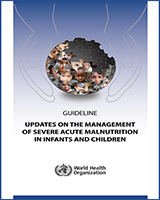Annex 5Summary of considerations for determining the strength of the recommendations
1. Admission and discharge criteria for children who are 6–59 months of age with severe acute malnutrition
Benefit or desired effect
Identification of high-risk children and provision of a high level of coverage
Active case-finding allowed, with improved coverage
Reduced mortality and other adverse outcomes
Markedly improved outcome for vulnerable children
Potential risks or undesired effects
Overdiagnosis of children with severe acute malnutrition
Early discharge of oedematous child who has not fully recovered; a minimum length of stay may be advocated
May keep children in programme too long
Other values/preferences/acceptability
Cost considerations
Increase in absolute costs of programme, owing to increased number of children being identified, but no change in cost effectiveness of interventions
Potential savings, with earlier detection and reduced number of children being admitted with complicated severe acute malnutrition
Feasibility of implementation
2. Where to manage children with severe acute malnutrition who have oedema
Benefit or desired effect
Potential risks or undesired effects
Other values/preferences/acceptability
Cost considerations
Feasibility of implementation
3. Use of antibiotics in the management of children with severe acute malnutrition in outpatient care
Benefit or desired effect
Potential risks or undesired effects
Other values/preferences/acceptability
Evidence of effect in oedematous malnutrition in settings of high HIV prevalence
No evidence of effect in wasting
An inexpensive intervention (less than US$1) that is shown, in one well-conducted study, to reduce mortality
Only one study
Cost considerations
Feasibility of implementation
Feasible, except in countries with high case-load
Amoxicillin already widely available
Requires minimal additional interaction between health-care workers and caregivers
4. Vitamin A supplementation in the treatment of children with severe acute malnutrition
Benefit or desired effect
Reduction of early mortality in children with severe acute malnutrition
Prevention of vitamin A morbidity, e.g. eye changes
Avoidance of potential toxicity associated with providing too much vitamin A
Potential risks or undesired effects
Other values/preferences/acceptability
Cost considerations
Feasibility of implementation
Should be feasible as interventions (vitamin A supplements and therapeutic foods) are already in place; rationalizing supplementation should make care more efficient
Will require training to clarify recommendations
5. Therapeutic feeding approaches in the management of severe acute malnutrition in children who are 6–59 months of age
Benefit or desired effect
Reduced mortality and cost and time in an inpatient facility
Improved acceptability
Clarification and harmonization of recommendations on therapeutic foods in different populations and medical conditions (e.g. presence of diarrhoea)
Potential risks or undesired effects
Other values/preferences/acceptability
Magnitude of the problem of the transition phase is largely undocumented
Reduce defaulter rates, improve acceptability
Cost considerations
Feasibility of implementation
6. Fluid management of children with severe acute malnutrition
Benefit or desired effect
Potential risks or undesired effects
May be some undesired side-effects
Danger of over-aggressive care at too early a stage
Case recognition difficulty with the metabolic disturbances of severe acute malnutrition
Other values/preferences/acceptability
Cost considerations
Feasibility of implementation
7. Management of HIV-infected children with severe acute malnutrition
Benefit or desired effect
Clarification of the most beneficial interventions for HIV-infected children with severe acute malnutrition, especially the most appropriate timing for the initiation of antiretroviral drug treatment and how management approaches for HIV-infected children differ from those for uninfected children with severe acute malnutrition
Rapid identification of HIV-infected children who are eligible for lifelong antiretroviral drug treatment and safe and appropriate initiation of treatment
Reduction of the likelihood of families or caregivers of HIV-infected children being exploited for commercial gain, namely by clarifying which interventions have proven efficacy for malnourished HIV-infected children and which provide no benefit
Identification of the most significant knowledge gaps that need to be addressed through research
Potential risks or undesired effects
Recommendations may not appropriately account for significant differences in the pathophysiology of severe acute malnutrition in HIV-infected children compared to HIV-uninfected children with severe acute malnutrition
The lack of pharmacokinetic data from HIV-infected children with severe acute malnutrition may result in antiretroviral drug treatment being implemented at a time that is less safe or in doses that are not appropriate
Other values/preferences/acceptability
High value was placed by guideline development group members on the potential of antiretroviral drug treatment to improve the survival of HIV-infected children with severe acute malnutrition. Early experiences are that antiretroviral drug treatment is well tolerated and provides significant clinical benefit with no greater rate of adverse events compared with HIV-infected children who are not severely malnourished
The dearth of direct evidence in the population; the guideline development group highly recommended the research agenda
Cost considerations
Feasibility of implementation
8. Identifying and managing infants who are less than 6 months of age with severe acute malnutrition
Benefit or desired effect
Reduced mortality and early treatment improves growth outcomes
Of major relevance, with epidemiological data indicating significant numbers of infants with severe acute malnutrition who have not previously been recognized and cared for in a way that is appropriate for their age (i.e. physiological differences from older children)
Provision of basic guidance in the absence of any prior recommendations
Potential risks or undesired effects
May be interpreted as undermining breastfeeding policy
May wrongly identify low-birth-weight babies who are actually growing appropriately
Inadvertent use of formula may increase mortality and morbidity
Large numbers of infants may be identified as severely malnourished, but with no clear programme to treat
Risk of nosocomial infections if admitted
Other values/preferences/acceptability
Young children at risk of being harmed by the inappropriate care in programmes, i.e. being treated the same way as children with severe acute malnutrition who are more than 6 months of age
Problem currently ignored or not accepted by society
Difficulties conducting appetite tests in this age group
Cost considerations
Feasibility of implementation


